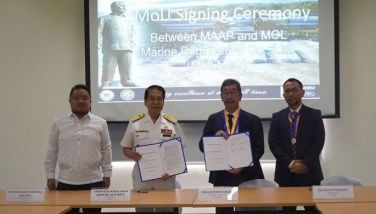Lost opportunities
There was a time in the late 1950s when “Made in the Philippines†was not a joke and there was ample reason to believe that the rising spirit of capitalism would somehow extricate the country from agrarian and colonial bondage.
Before Sony and Toyota became synonymous with industrial might — as we are so often reminded, to put some context to this brief optimistic episode in Philippine history — “Made in Japan†was a code word for shoddy manufactures that easily broke down or fell apart. If Japan could rise above this cruel stereotype, why couldn’t we?
Some 60 years ago, the Philippine economy was mainly based on sugar, coconut and mining, as it had been before independence. Agriculture and extractive products with low value-added worth accounted for most exports, which were bound almost exclusively for the United States and Japan. A lion’s share of heavy machinery, finished goods and consumer imports came from the former colonial power.
What passed for local manufactures were limited to beer, soft drinks, cigarettes and school supplies, the owners of which were either Americans, Castilaloys or a shadowy Chinese mafia with local dummies.
Utilities like the telephone and electric monopolies were American-owned and run by absentee boards from distant New York.
Of course there was Philippine Airlines, which since liberation was operated by the Sorianos of San Miguel, the nation’s first conglomerate built by its famous beer. PAL was heavily favored by every administration from Roxas to Garcia until its luck ran out when President Diosdado Macapagal took power in 1962 and handed control to his own Castilaloy crony, Benny Toda. Surviving into the Marcos era, Toda was ousted for unwisely billing Imelda Marcos for her numerous foreign trips during martial law.
From the mid-1970s, PAL was run into the ground by Marcos favorites and eventually Cory Aquino’s people until unabated losses could no longer be covered by the government and it had to be privatized. It became Lucio Tan’s airline and reemerged as the laggard among Asian airlines, some of today’s industry icons which PAL antedated and even helped get off the ground.
Still, bright hopes were at one time raised for the future of capitalism under the slogan of “Filipino First.†Senator Claro M. Recto was the patron saint of the post-war nationalism, which championed “nationalist industrialization†as the antidote to American political and economic domination. This was the program designed for the nascent industrialist class on which the Carlos Garcia regime (1957-61) lavished bank loans and millions of reparations grants drawn from Japan’s financial settlement for the atrocities and damages it inflicted on the country in World War II.
Overnight, Quezon City, Caloocan, Marikina, Pasig and Makati — all on the outskirts of Manila — were brimming with textile mills, shoe factories, cement plants, food manufacturing plants, furniture makers, and all kinds of small factories specializing in kitchen and household items.
Although the succeeding Macapagal administration imposed decontrol and vowed to roll back Garcia’s Filipino First policy, it gave the “go†signal for the Jacintos, his other cronies (not Castilaloys for a change), to establish the biggest investment of all — a huge steel plant in Iligan City, Mindanao.
With a Filipino-owned oil-refinery (Fil-Oil) and the Iligan Integrated Steel Mill to back up its ambitions for industrial development, the Philippines was deemed on par with ambitious South Korea and Taiwan in imitating Japan’s model of post-war industrialization. It was also far ahead of Indonesia, Malaysia and Singapore which were technically at war with each other following the withdrawal of British colonial power.
When Ferdinand Marcos became president in 1966, his bold development plans called for an orgy of infrastructure building — major roads, bridges, ports and public works that were soon the envy of our Asian neighbors. The private sector showed incredible dynamism by turning Ayala Avenue into the first Wall Street lookalike in the region. Marcos invited the big Detroit car manufacturers Ford, GM and Chrysler as well as Japan’s Toyota to build car assembly plants for the local and regional car market.
To empower small entrepreneurs on the local level, a retail trade nationalization law had earlier been passed to push out the ethnic Chinese from a field it had dominated since the Spanish colonial years. Marcos, however, unilaterally decreed the naturalization of hundreds of these aliens, effectively nullifying the law and setting the stage for Chinese taipans to emerge among the richest Filipino dollar billionaires within two decades.
Although high-profile projects easily won brownie points from the public, what convinced many Filipinos that their country stood at the brink of an economic takeoff was the existence of homegrown entrepreneurs whose products stood good chances of competing with foreign brands and, in time, could penetrate regional, if not world markets.
In at least two products, beer and shoes, the Philippines appeared far ahead or at least competitive with western and other Asian brands.
San Miguel Beer was famous all over Asia. It won a big slice of the Vietnam market during the Vietnam War. Until three or so years ago, one of the biggest neon signs in Hong Kong’s Victoria Harbor was of San Miguel in Causeway Bay. Before Communist China opened itself to capitalism in the late 1980s, San Miguel was the preferred foreign beer in that country.
Until the late 1950s, when Ang Tibay inexplicably vanished from the market, it was the nation’s favorite leather footwear and a whole parallel shoe industry flourished in Marikina, just west of Manila. Tanning of leather, apart from jewelry-making, was the main industry of Meycauayan, Bulacan, just north of Manila, the putrid smell it generated for miles around proof of its bustling economic status.
Long before Nike and Adidas came into the market, Filipinos had Elpo and Marcelo as the answer to Converse and Keds rubber shoes.
Like San Miguel, which could count on vital openings to Asian regional markets, Ang Tibay and Elpo seemed ideally positioned for export. America’s giant shoe industry was moving out of New England to the Southwest and eventually to Brazil, Mexico and Spain. Even if Ang Tibay was too far from the US to compete there successfully, it was certainly in a position of advantage in war-torn Indochina and recently independent Malaysia and Singapore, where industrial development was in its infant stages.
Another San Miguel product, Magnolia Ice Cream, won acceptance all over Asia in this period but somehow never established itself permanently in the region. To this day, foreign tourists departing for neighboring countries take home ice-packed Magnolia products. Selecta, another local ice cream uniquely based on carabao milk (the main ingredient of the best Italian mozzarella cheese) could have developed an export market but never did.
Max’s Fried Chicken which was Manila’s rage of the 1960s could have given Kentucky Fried Chicken a run for its money instead of waiting some 30 years to belatedly and lamely break into the US ethnic market. Contrast this record to the early 2000 foreign offensive of Jollibee, a virtual copycat of McDonald’s that not only beat the latter in the Philippines, but has succeeded in making inroads in North America, China, Southeast Asia and the Middle East.
Back in the 1970s when the Asian population was building up in the United States, there was a surging demand for all kinds of native food and condiments like patis (fish sauce), noodles and prepared sauces. For some reason or another, Filipino brands like Rufina Patis and Aling Asyang sauces which had a headstart in the market were outpaced by Thai and Vietnamese, not to mention Taiwanese and Chinese brands.
On the fashion front, Ready-To-Wear (RTW) clothes could only have been a natural outlet for Filipino clothes designers who kept abreast of fashion trends and perhaps were better known in the region than Kenzo or Hanae Mori in the 1960s.
But Ramon Valera and Pitoy Moreno preferred to make haute couture for the inward-looking Filipino elite, aspiring to dress up the world’s rich and famous in doomed competition with long-established Parisian designers. It took Ben Chan, more low-key and practical, to develop Bench casual wear for young people from factories in China and slowly build a regional brand rivaling Giordano and Bossini starting in the 1990s.
Why did Filipino entrepreneurs of the 1950s fall short of realizing their full potential not only in the Philippines but in foreign markets?
Lack of capital, government indifference, and foreign tariff walls are oft-repeated reasons cited. But these tell only part of the story. What’s more likely was that Filipino entrepreneurs became victims of their very success in their own country. They looked inward to a safe domestic market and ignored the cumbersome prospects of exports. In the pre-war years, for instance, Ang Tibay provided shoes for the whole army. For decades, school children by the hundreds of thousands, including my baby boomer generation, were a solid captive market.
Long before American fastfood brands invaded Manila in the 1970s, Filipino cuisine unquestionably ruled the field. Max’s Fried Chicken outlets were always packed to the rafters. So was Aristocrat and the other competitors like D&E, Bulakena and Eugene’s.
Even during the martial law days, Glenda Barretto’s Via Mare was eternally busy and highly profitable. Unfortunately, all these restaurants never branched out of their Metro Manila comfort zone until the opportunity was lost to penetrate a wider market.
“There simply was no motivation,†notes one writer, “to move out to distant foreign markets and work harder. They were already making good money right here in Manila. It took them two or three decades more to branch out to Cebu, Davao and even nearby provinces in Luzon. Why complicate matters?â€
Left unsaid were second- and third-generation conflicts that tended to annul the pioneering successes of the founding fathers of some major enterprises. The most prominent case was Ang Tibay, a giant in its time, which literally went into pieces upon the death of Don Toribio Teodoro.
For those firms that survived their founders’ disappearance, franchising took time to be an attractive idea. Apart from Jollibee, Chowking and allied company’s today’s franchising efforts appear limited to small-time products like hotdogs, waffles and native snacks dispensed by one-man carts in schools and street corners. Such unpromising business models could not exactly be replicated beyond Philippine territory and culture.
San Miguel never lacked capital or managerial and promotions knowhow. But it went through incredible family strife, starting with the mid-1980s fight among the Castilaloys that gave Danding Cojuangco the vital opening to buy them out. Then Ninoy Aquino was assassinated and the company, tagged by the anti-Marcos forces as a crony business, was subjected to a crippling boycott just at the time when it should have been flexing its muscles in the region. Under Cory and Ramos, it barely stayed afloat.
Only when Danding and his man Ramon Ang took over after 1998 did the shattered conglomerate regain its old stride. Today, it’s back to old glory and has spread its wings into energy, oil, and a major share in Philippine Airlines.
PAL perhaps presents the saddest story of all. It was Asia’s “First Airline†as its blurbs put it. It had a gold mine in the Central Pacific route to the US West Coast and first call on Hong Kong and regional destinations. It was there to harvest incredible benefits from the Filipino diaspora to the Middle East. Until 1997, it was flying direct to major European cities.
More important, some PAL old hands tell you, the airline was a recognized industry leader. It helped Japan Airlines and Singapore Airlines with the latter’s birth pains, training ground and cabin crews. But the airline itself was a victim of gross political abuse and corruption.
At one time, Lucio Tan, its present owner, was asked by a journalist about PAL’s future prospects, particularly in cashing in on the opening of the China market.
“I don’t think so,†he says of PAL’s supposedly vast earning potential. “In first class, we have all these government officials flying free, in business class everybody there is upgraded from economy, and in economy, the balikbayans all have these huge boxes that overload our planes. How can we make any profit?â€
In short, PAL had to downsize practically to near-extinction, losing many golden opportunities to be run like a world-class airline. In contrast, the president of Singapore Airlines was once asked by Filipino guests how the company had become the world’s best and most profitable in just 15 years or so.
“We are owned by our government,†he says at the company’s headquarters in Changi Airport, “but Prime Minister Lee Kuan Yew told us to run it the way an airline should be and to make a good profit. Government will never interfere. Politicians keep away. We are expected to do our best. No excuses. If we lose money, we are fired.â€
Just think, says a former PAL executive, of the very lucrative assets PAL once had in catering and aircraft maintenance. “These were just sold off piece by piece after we became privatized. We had prime real estate like that in San Francisco, right on Union Square, but the government put in on fire sale and its cronies made millions overnight.â€
The Manila Hotel, now a shadow of its glorious past, we are told by some sentimental old Manilans, could have been developed into a regional or global hotel chain. It could have given Malaysia’s Shangri-La, comparably a latecomer to the luxury hotel business, a run for its money.
In fact in 1989, when Beijing’s Palace Hotel was built to be China’s first five-star hotel, its initial operations and staff training were set up by consultants and experts from Manila Hotel.
“We had to train those lobby girls how to dress up and walk,†says Gina Valdez, who supervised training in the Beijing hotel (now the Peninsula) before it opened around the time of the June 1989 Tiananmen Massacre. “They began from scratch, from kitchen to room and concierge services, and I’m proud to say that we Filipinos played a big part in getting them started. We could have done it for ourselves and made our own brand truly international but we blew it.â€
Not only were Filipino products at the brink of regional expansion, Filipino managerial talent were sought out to develop skills and operating systems for many fledgling foreign conglomerates. Think of PLDT’s Manny Pangilinan as the boy wonder of the Salim group at the height of its power in Suharto’s Indonesia. Or renowned architect Jun Palafox designing whole upscale business and residential complexes all over the Gulf States.
These achievements are a far cry from today’s grim situation wherein even basic items like toothpaste and biscuits are manufactured outside the Philippines and we are only called upon to provide lowly paid, non-skilled labor in the uttermost parts of the earth. The best and the brightest of our middle class and professionals have long been compelled by necessity and despair to seek foreign citizenships.
Alas, in the brave Old-New World of privatization and globalization, of hot money and casino stock markets, the Philippines has won a unique place for breeding incongruous, far-from-exemplary billionaires at the same time its hapless people are pushed by the millions into the gilded slave markets of the 21st century.
Something went terribly amiss and we’re still reeling from the pain and punishment of lost opportunities.















